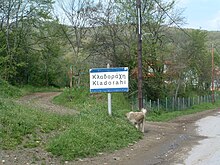Kladorrachi
This article, Kladorrachi, has recently been created via the Articles for creation process. Please check to see if the reviewer has accidentally left this template after accepting the draft and take appropriate action as necessary.
Reviewer tools: Inform author |
Kladorachi | |
|---|---|
Settlement | |
| Coordinates: 40°49′37″N 21°23′46″E / 40.827045°N 21.396005°E | |
| Country | Greece |
| Administrative region | West Macedonia |
| Regional unit | Florina |
| Municipality | Florina |
| Elevation | 604 m (1,982 ft) |
| Population (2011)[1] | |
| • Community | 93 |
| Time zone | UTC+2 (EET) |
| • Summer (DST) | UTC+3 (EEST) |
| Postal code | 531 00 |
Kladorachi (Greek: Κλαδορράχη, before 1926: Κλαδοράπη - Kladorapi,[2]. Kladorachi is a village in the Florina regional unit, West Macedonia, Greece. It has also been known as Kladorrachi, Kladorobi, Kladorahi, Kladorohi, Kladorabi and Kladoraki. Since the 2011 local government reform it is part of the municipality of Florina.[3]. It was previously part of the municipality of Kato Kleines. It is located 5km north of the city of Florina.

Places of Worship
The church of St. Procopius, built in 1874, is located in the village centre.
The St. George's cemetery chapel located in the village was built in 1919.
The Holy Monastery of the Assumption of the Virgin Mary (Koimisis tis Theotokou) is to be found 1.9 km to the west of Kladorachi.
It was built in 1803, rebuilt after a fire in 1880 and restored in 1955.[4]
Next to it is the colourful church of the Virgin Mary.
Landmarks
During World War 2, on August 9, 1943, the Germans sought retribution after the death of a German officer in an ambush by a resistance group on the Florina to Kladorachi road. They initially demanded the hanging of 15 Greek citizens, and raised the number to 50 in the event that two other German prisoners were not released.
The first Greek to be arrested was Theodoros Thomaidis, the maestro of the Aristotelis Cultural Association's choir. He was hanged in the gallows side-by-side with the priest of a nearby village, a woodcutter, two members of the local Jewish community, and 10 more victims from surrounding villages.
Their bodies were left for three days at the site of their hanging as a warning. The two German prisoners were subsequently released and thus 35 more citizens were saved from hanging.
After the bodies were taken down from the gallows and buried, Evangelos Katergaris, a member of the Aristotelis Association, cut the noose with which Thomaidis was hanged and kept it in his home for 20 years. The noose was later turned over to the association and preserved as a legacy. [5]
A memorial was erected, which lists all those hanged.
Population
An Ottoman defter of 1481 recorded 108 households in the village.[6]
| Year | Population | Reference |
|---|---|---|
| 1905 | 384 | [7] |
| 2001 | 75 | [8] |
| 2011 | 93 |
Many residents left in the 1950s and 1960s in search of a better life and went to the U.S., Canada, and Australia.
-
St George's cemetery chapel in Kladorachi
-
Interior of the St George's cemetery chapel in Kladorachi
-
Church of St. Procopius in Kladorachi
-
A stork on the top of the church of St. Procopius in Kladorachi
-
The Holy Monastery of the Assumption of the Virgin Mary was founded in Kladorachi in 1803
-
Derelict cafe in Kladorachi
-
House in Kladorachi
-
Abandoned house in Kladorachi
-
The memorial commemorating all those that were hanged in Klodarachi on 9 August 1943
-
The memorial lists all those hanged in Klodarachi on 9 August 1943
References
- ^ "Απογραφή Πληθυσμού - Κατοικιών 2011. ΜΟΝΙΜΟΣ Πληθυσμός" (in Greek). Hellenic Statistical Authority.
- ^ Name changes of settlements in Greece
- ^ Kallikratis law Greece Ministry of Interior (in Greek)
- ^ Кладоробски манастир (in Greek)
- ^ "Maestro Thomaidis' noose to be displayed in Dresden Military History Museum", Athens News Agency: Daily News Bulletin in English, 10-02-27. #22
- ^ Kravari, Vassiliki (1989). Villes et villages de Macédoine occidentale. Réalités byzantines (in French). Vol. 2. Paris: Editions P. Lethielleux. p. 280. ISBN 2-283-60452-4.
- ^ Dimitri Mishev and D. M. Brancoff, La Macédoine et sa Population Chrétienne, p. 176 (in French)
- ^ "Population & housing census 2001 (incl. area and average elevation)" (PDF) (in Greek). National Statistical Service of Greece.
This article, Kladorrachi, has recently been created via the Articles for creation process. Please check to see if the reviewer has accidentally left this template after accepting the draft and take appropriate action as necessary.
Reviewer tools: Inform author |












